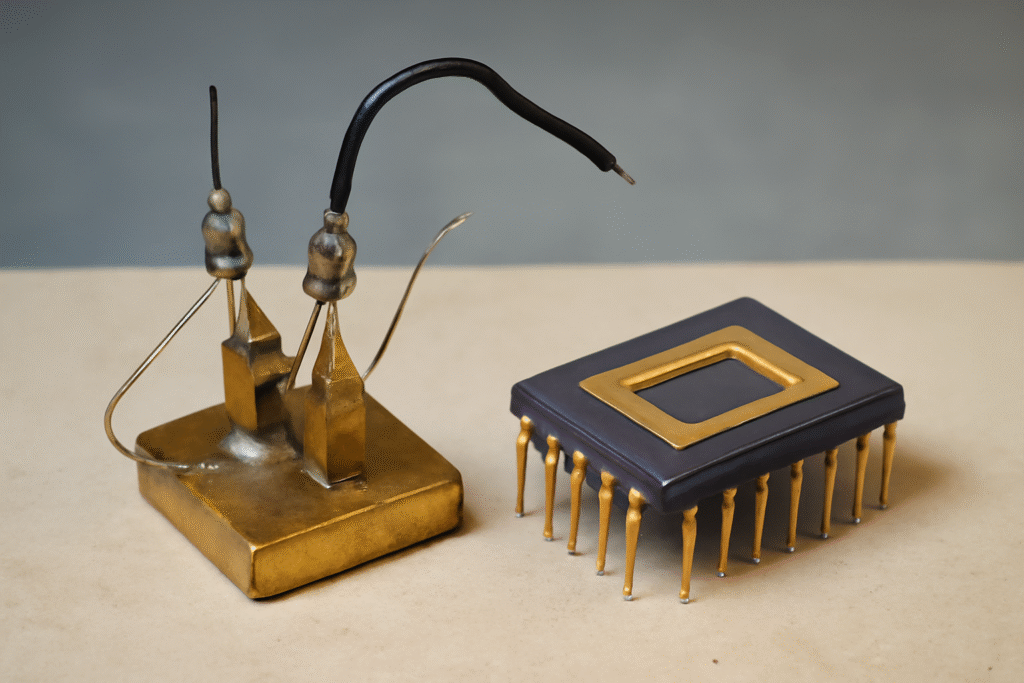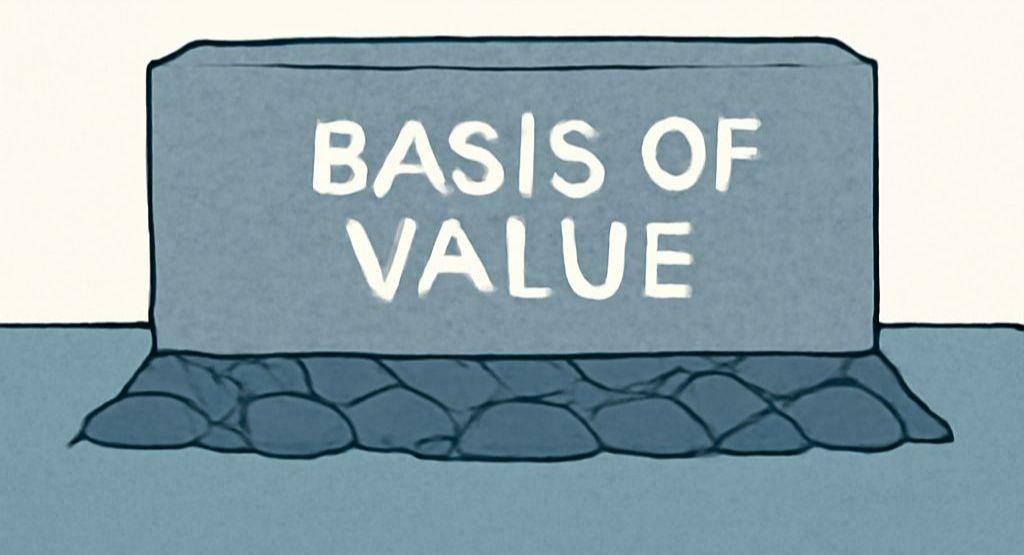The invisible engine powering every electronic item that we see around

Today, we’re diving into a product that barely got any attention until the world ran out of it. When COVID hit, its sudden shortage didn’t just raise eyebrows but brought factories across industries to a screeching halt.
You’ve probably guessed it by now: we’re talking about SEMICONDUCTORS.
The invisible engine
Semiconductors are the invisible engine behind modern life. You don’t see them, but they’re everywhere, in your phone, car, microwave, laptop, hospital scanner, power grid, and even in fighter jets. Think of them as the “brains” and “muscles” of electronics: they make things think (process data), remember (store data), and act (control machines). Comfortably, it’s fair to say that Semiconductors are to the 21st century what steel was to the 19th and oil was to the 20th. They’re the invisible infrastructure of our digital, connected, and automated world.
Out of sheer curiosity, we’ve been digging deep into the semiconductor space for a while. And over the next few editions, we’ll share our insights with you, layer by layer, in plain English.
Today, we begin at the very start: what electronic manufacturing looked like before semiconductors changed the game and who were the people involved in driving this change. Let’s dive in…
Travelling back in time – The Age of Vacuum Tubes
Before the invention of semiconductors, electronics were big, slow, hot, expensive, and fragile. In the first half of the 20th century, the electronics industry relied on vacuum tubes, glass tubes that could amplify and switch electrical signals. Here’s what electronics looked like back then:
Size: Devices were huge, room-sized computers and suitcase radios.
Heat & Power: Tubes ran hot and sucked power like crazy.
Reliability: They broke often and had short lifespans.
Cost: Expensive to build, assemble, and maintain.
Despite these limitations, vacuum tubes enabled early breakthroughs: The first radios and televisions, WWII radar systems, the ENIAC (1945), the world’s first general-purpose computer, which used 17,000 tubes!
Picture this: You needed a full table or even a whole cabinet to perform basic calculations. There were no transistors, so computers were rare, slow, and limited to governments, the military, and universities. There was no integration, everything was built using individual parts. Consumer electronics were luxury goods, not mass products.

(Image of a vintage 1950s vacuum tube radio. It captures the exposed vacuum tubes, warm wooden cabinet, and the illuminated tuning dial, giving a clear representation of what early electronics powered by vacuum tubes looked like.)
Though vacuum tubes were a breakthrough in their time, it quickly became clear they weren’t built for the future. The game changed when some of America’s brightest minds came together at Bell Labs during World War II. Among their many inventions was something that would quietly reshape the modern world: the semiconductor. The sleek, scalable successor to vacuum tubes.
The Breakthrough Invention – Birth of Semiconductors
The idea that certain materials, known as semiconductors, could control the flow of electricity was proposed as early as the 19th century. Fast forward to 1947, John Bardeen, Walter Brattain, and William Shockley at Bell Labs invented the transistor. This breakthrough was the key moment in semiconductor history. The transistor could amplify electrical signals (like a vacuum tube) but in a tiny form, with lower power consumption, greater reliability, and no heat issues. The transistor was made from semiconductor materials, such as germanium and later silicon. By applying precise amounts of electrical current, transistors could control or switch electronic signals, doing what vacuum tubes did, but in a far more efficient and compact way.
Then came the next evolution, which truly unlocked the power of semiconductor materials and the transistor. In 1958-59, Jack Kilby at Texas Instruments and Robert Noyce at Fairchild Semiconductor are credited with inventing the integrated circuit (IC), which took semiconductor technology a significant step further. The invention of the IC allowed entire circuits (comprising many transistors) to be placed on a single chip, making computers, radios, and television sets smaller, cheaper, and more reliable. This was the birth of miniaturization.

Conceptual images of the first transistor (left) and the first IC (right) that transformed the electronics industry.
While germanium was used in early transistors, silicon became the dominant material in semiconductor manufacturing by the 1960s. Silicon is more abundant, stable, and easier to work with compared to germanium.
Shockley Semiconductor and the Traitorous Eight
The story of Shockley Semiconductor and the Traitorous Eight is one of the most fascinating episodes in the history of the semiconductor industry. It revolves around a combination of innovation, internal conflict, and ambition that ultimately led to the creation of Fairchild Semiconductor, a company that played a central role in launching Silicon Valley and revolutionising the electronics industry.
William Shockley, a physicist and co-inventor of the transistor at Bell Labs (along with Bardeen and Brattain), became one of the pioneers of semiconductor technology. After winning the Nobel Prize in Physics in 1956 for his work on the transistor, Shockley left Bell Labs and set up his own company: Shockley Semiconductor Laboratory. The reason behind this move was that the transistor had proven to be a revolutionary technology, and Shockley was eager to develop and commercialise it further. This became the first company to focus on the commercial production of semiconductors.
His primary goal was to develop the technology that would lead to the creation of integrated circuits (ICs). To support him in this endeavour, he had a group of talented engineers and physicists who worked for Shockley Semiconductor. Shockley’s management style was highly authoritarian, and he was known to be difficult to work with. He was very demanding and expected a great deal from his employees, which led to tensions within the company.
This resulted in a group of eight members leaving Shockley Semiconductor and starting their own company, Fairchild Semiconductor. This move resulted in Shockley giving them a derogatory name, the “Traitorous Eight.”

Significance of Fairchild Semiconductor’s role
The reason Fairchild Semiconductor was so important was that it achieved a breakthrough in ICs, which would go on to revolutionise electronics by allowing multiple transistors to be placed on a single chip. Fairchild became one of the first major semiconductor companies in the Palo Alto area, which would later come to be known as Silicon Valley. The company was a key player in the formation of Silicon Valley as a global hub of technology and innovation.
Additionally, two members (Robert Noyce and Gordon Moore) out of the eight went on to found INTEL, the company that powers most of PC that we use today. In short, Fairchild Semiconductor played a pivotal role in the mass production of integrated circuits (ICs) and the advancement of silicon technology, which paved the way for innovations ranging from personal computers to smartphones.

Then vs Now – Evolution of Semiconductors till Today
In 1971 (24 years after the transistor invention), Intel introduced the Intel 4004, the world’s first microprocessor. This development allowed computers to be smaller and more affordable. By the 1990s, semiconductor companies were able to pack millions of transistors onto a single chip, creating multi-core processors capable of performing thousands of calculations per second. Chips became the brain of everything from home entertainment systems to automated factories. Later in the 2000s, the introduction of smartphones was a pivotal moment. These chips integrated a CPU, a GPU, radio-frequency chips, and memory onto a single device, making mobile computing powerful and portable.
Today, semiconductors power everything from smartphones to cars, AI systems, space exploration, and even medical devices. Modern chips have billions of transistors packed onto a single chip, with sizes shrinking to the nanoscale. Modern chips are tiny, with semiconductor manufacturing now working at the 5nm node. A 5nm process means that the transistors on the chip are 5 billionths of a meter in size, making them faster, more power-efficient, and more compact than ever. A single high-end smartphone today has a multi-core processor with more processing power than the supercomputers of the 1980s. Today, Semiconductors are truly the invisible engine of the electronic world.
Up Next…
We are confident that you now have a thorough understanding of the history of semiconductors. In the upcoming newsletters, we will continue to get deeper into our understanding of the industry, one layer at a time. Stay tuned…
Happy Investing!!!
Disclaimer: These insights are based on our observations and interpretations, which might not be complete or accurate. Bastion Research and its associates do not have any stake in companies mentioned. This newsletter is for educational purposes only and is not intended to provide any kind of investment advice. Please conduct your own research and consult your financial advisor before making any investment decisions based on the information shared in this newsletter.
🤣MEME OF THE WEEK🤣





